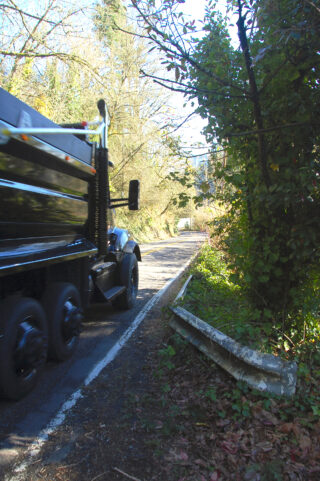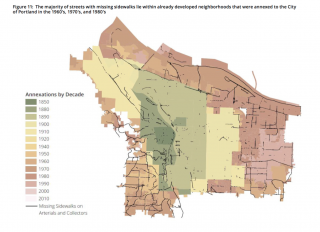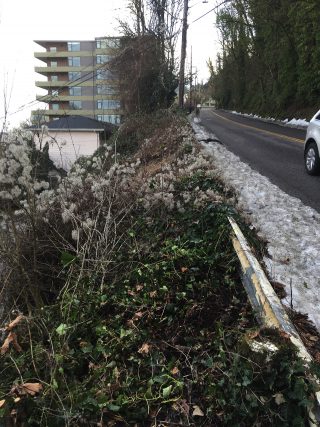
(Photos courtesy friend of the author)
Would you feel safe on this street?
__
Getting a sidewalk built, or even a path on the side of the road, is too often a herculean effort, one that is becoming increasingly relevant now that the Residential Infill Project (RIP), which will hasten more development, has gone into full effect. The city’s historic strategy of relying on development to provide sidewalks and bike lanes is not working for southwest Portland—and maybe not for other areas too—but as the Southwest Correspondent I’ll stick to the streets I know best.
The Portland sidewalk spiel goes something like this. In the beginning, there was the Annexation by Decade map (below). It explains a lot. The original development of the central city included sidewalks, and many of those old sidewalks are still in place. The 100 year old sidewalk on my street has held up really well, although a few years ago the city made property owners fix the cracks, per city code 17.28.020:
The owner(s) of land abutting any street in the City shall be responsible for constructing, reconstructing, maintaining and repairing the sidewalks, curbs, driveways and parking strips abutting or immediately adjacent to said land…
Advertisement

In the mid-20th century, Portland began annexing parts of unincorporated Multnomah County, mainly in what are now southwest and east Portland. The County didn’t have a sidewalk requirement, so those areas joined the city sidewalk-less, and they lack complete networks even today. However, any new development or substantial expansion is required to build sidewalks per the city ordinance above. That is why you can find patches of sidewalks, or “sidewalks to nowhere” in places. Eventually, with enough new development, and with various City infill projects, these areas will arrive at a more complete network.
That is the simple Portland sidewalk story.
Things get more complicated when you take stormwater management requirements into account. As the Streets 2035 report showed, on the westside stormwater drains into streams (with the exception of downtown). This means that new cement sidewalks can’t comply with federal EPA standards unless they treat the stormwater, like what the city is doing on SW Capitol Highway—at a cost of $27.5 million for one mile of bicycle and pedestrian facilities.
That stormwater expense is the reason that the city often doesn’t require new construction in the southwest to build cement sidewalks. The sidewalk requirement gets reduced to a 6 ft shoulder on the side of the road, but I’ve seen it go down to 3 ft if the ROW is constrained.
The city has ordinances which require new development to meet minimum transportation standards in order to be approved, including (at least prior to 2018) a “safety for all modes” clause (that’s where improvements for walking and riding a bike come in). In an region with the the narrowest ROW in the city, however, developers struggled to meet the “safety for all modes” requirement. That might be why in 2018 the city watered-down the transportation requirements to say:
Evaluation factors may be balanced; a finding of failure in one or more factors may be acceptable if the failure is not a result of the proposed development
That’s a pretty big loophole for a policy that is intended to provide infrastructure to a region with glaring deficiencies. Because the requirements can be mitigated, or modified in an “Alternative Review,” the process becomes subjective, with the result that neighbors or neighborhood associations appeal the approvals, and those appeals end up before the City Council, the state Land Use Board of Appeals, or eventually the state courts. In these land use cases you will hear legal jargon like “nexus” and “proportionality,” or of “Nollan/Dolan” rulings which limit and proscribe the improvements a municipality can exact from a developer.
In a nutshell, I interpret Nollan/Dolan as meaning that you can require a development to ice a cake, but you can’t make them bake it. Southwest Portland is an unbaked cake. Nollan/Dolan and lack of stormwater infrastructure make it difficult for the city to enforce the frontage improvements required by code.
Building a sidewalk doesn’t seem so simple anymore!
Out of frustration and impatience with unsafe streets someone like Michael Reiss considers painting his own advisory shoulders, or Don Baack grabs a shovel and builds nearly 50 miles of trails, or a friend of mine spends the summer bushwhacking paths in Portland Heights.
Let’s look a little more closely at one of my friend’s bushwacking projects. He cleared the weeds in back of a guardrail to make a path on a city-owned width of land near the bottom of SW Broadway Drive. The location is the densest area of Portland Heights, with several apartment buildings, a condominium complex, and houses rented out to groups of students. A new 20-unit townhouse project was approved for development last year. Yet for all this density, the city has not exacted enough from developers to provide residents with a connected place to walk. Lower Broadway still only has patches of sidewalk and the residents, many of them renters, cannot safely walk downtown to where they work and go to school.
My friend decided to do something about it. The city engineer was so impressed with his work, and the urgent need for safety improvements, that she had the last segment of guardrail removed so that people didn’t have to climb over it to reach his path. With his volunteer work and the cooperation of the city, folks now use his path and are a little more protected on their way downtown.
This isn’t a rural environment. It’s a couple hundred yards from where the 6th and 4th Avenue protected bikeways are going in. It’s across I-405 from PSU. It’s near where the southwest corridor lightrail was to fly over 405 into downtown.
Southwest Portland is not getting sidewalks. Grassroots efforts like SWTrails and my friend’s bushwhacking might point a way to a solution, the city should support their work. Making it easier to become indemnified would help.
The questions are 1), how will the city make streets safe for all users on roads too narrow for bicycle and pedestrian facilities? 2) how much car-dependent development will the city continue to allow in neighborhoods lacking active transportation facilities or adequate public transportation?
Disclosure: I was involved in preparing a Broadway Drive Land Use case before the City Council and the Land Use Board of Appeals.

— Lisa Caballero, lisacaballero853@gmail.com
— Get our headlines delivered to your inbox.
— Support this independent community media outlet with a one-time contribution or monthly subscription.




